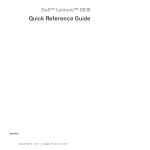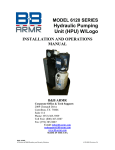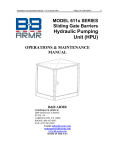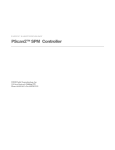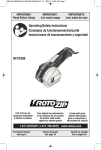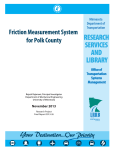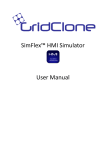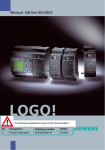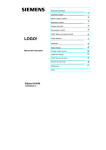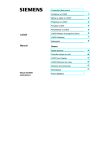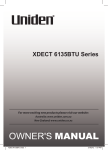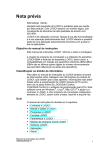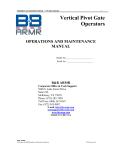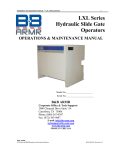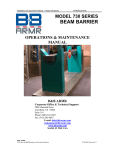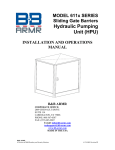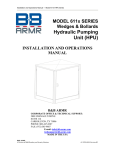Download model 480 series sliding gate operations
Transcript
MODEL 480 SERIES SLIDING GATE OPERATIONS & MAINTENANCE MANUAL B&B ARMR OFFICE AND TECHNICAL SUPPORT: 2009 CHENAULT DRIVE CARROLLTON, TX 75006 SUITE 114 PHONE: (800) 367-0387 FAX: (972) 385-9887 MADE IN THE USA Operations Manual — Model 480 Series © 2014 B&B ARMR 0480-9001 Revision A3 INTRODUCTION ii Your safety is extremely important to us. If you have any questions or are in doubt about any aspect of the equipment, please contact us. INTRODUCTION Welcome! Congratulations on your purchase of a B&B ARMR vehicle barrier. In addition to providing detailed operating instructions, this manual describes how to install, maintain, and troubleshoot your vehicle barrier. If you require additional assistance with any aspect of your vehicle barrier's installation or operation, please contact us. We have years of experience in all aspects of perimeter security and related disciplines, and our products are used throughout the world to control access and to protect people, equipment, and facilities. We offer a broad range of vehicle barrier and related security services: Turnkey installations Routine barrier preventative maintenance or emergency repairs (including work on non-B&B ARMR products) Spare or replacement parts Custom designs or special installations Equipment upgrades (modernize your old equipment with state-of-the-art hydraulics and control systems) Ancillary security equipment such as security guard enclosures, card readers, security lighting, and many other security related products. Safety INTRODUCTION © 2014 B&B ARMR WWW .BB-ARMR.COM iii (800)-367-0387 Operations Manual — Model 480 Series SYMBOL MEANING: The lightning flash with arrowhead symbol, within an equilateral triangle, is intended to alert the user to the presence of uninsulated "dangerous voltage" within the product's enclosure that may be of sufficient magnitude to constitute a risk of electric shock to persons. The exclamation point within an equilateral triangle is intended to alert the user to the presence of important operating and maintenance (servicing) instruction in the literature accompanying the product. B&B ARMR does not assume responsibility for injury to persons or property during installation, operation, or maintenance. As the user, you are responsible for correct and safe installation, operation, and maintenance of this equipment. Users must follow the specific instructions and safety precautions located in this manual. In addition they must: Follow the safety standards of the Occupational Safety and Health Administration (OSHA), as well as other applicable federal, state, and local safety regulations and industry standards and procedures. For installation outside the United States, users must also follow applicable international, regional, and local safety standards. Engage only trained and experienced staff to install, operate, and maintain the equipment. Ensure that all repairs are performed correctly, using properly trained technicians and the correct tools and equipment. Additional safety devices may be included with this barrier system: o Vehicle loop detector(s) – Safety loop o Traffic arms o Traffic lights How to Contact Us If you have any questions or experience any problems with your vehicle barrier—or if we can help you with any other facility security issues—please contact us directly at: Office and Technical Support: 2009 Chenault Drive Carrollton, TX 75006 Suite 114 Phone: (800) 367-0387 Fax: (972) 385-9887 E-mail: [email protected] TABLE OF CONTENTS © 2014 B&B ARMR WWW .BB-ARMR.COM 5 (800)-367-0387 Operations Manual — Model 480 Series Table of Contents INTRODUCTION ............................................................................................................. 2 Safety .................................................................................................................................... 2 How to Contact Us .............................................................................................................. 3 1 ORIENTATION ............................................................................................................. 5 1.1 Overview .................................................................................................................................................... 5 1.1.1 Drive Stanchion .................................................................................................................................. 6 1.1.2 Receiving Stanchion ........................................................................................................................... 6 1.1.3 Gate Section ....................................................................................................................................... 6 1.1.4 Operator.............................................................................................................................................. 6 1.1.5 Battery Compartment ......................................................................................................................... 7 1.1.6 Battery Control Box ........................................................................................................................... 7 1.1.7 Support Wheels .................................................................................................................................. 7 1.1.8 Drive Wheels/Pinion .......................................................................................................................... 7 1.1.9 Options ............................................................................................................................................... 7 1.2 Final Pre-operation Checklist .................................................................................................................... 7 2 OPERATION .................................................................................................................. 8 2.1 Introduction................................................................................................................................................ 8 2.2 Control ....................................................................................................................................................... 8 2.3 Operating Time .......................................................................................................................................... 9 3 MAINTENANCE ........................................................................................................... 9 3.1 Introduction................................................................................................................................................ 9 3.2 Spare Parts................................................................................................................................................. 9 3.3 Monthly Inspections ................................................................................................................................. 10 3.4 Six-Month Inspections .............................................................................................................................. 11 3.5 Annual Maintenance Inspections ............................................................................................................. 11 4 TROUBLESHOOTING ................................................................................................11 4.1 Model 480 Troubleshooting Guide .......................................................................................................... 12 5 WARRANTY ................................................................................................................. 14 6 APPENDIX .................................................................................................................... 15 Equipment Maintenance Log Form ................................................................................................................. 15 © 2014 B&B ARMR WWW .BB-ARMR.COM (800)-367-0387 Installation and Operations Manual — Model 480 Series ORIENTATION 5 1 ORIENTATION 1.1 Overview The model 480 vehicle barrier is designed to contain a vehicle impact and prevent that vehicle from entering a restricted access control area. The barrier consists of two cast in place foundation stanchions, the cantilever gate panel, and barrier drive operator. © 2006 B&B ARMR Corporation WWW .BB-ARMR.COM (800)-367-0387 Installation and Operations Manual — Model 480 Series ORIENTATION 6 Figure 1: Model 480 Cantilever Gate barrier Figure 1 orients you to the basic components of the Model 480 vehicle barrier. 1.1.1 Drive Stanchion The drive stanchion supports the main structure of the barrier as well as all the necessary components to position the gate section closed and open. The “H” type design is engineered to provide both operational structural integrity as well as crash impact strength. 1.1.2 Receiving Stanchion The receiving stanchion holds the gate section in place during crash impact. This component also is engineered using the structural “H” section to allow for maximum strength and rigidity. 1.1.3 Gate Section The gate section provides the structure to move the impact force to the stanchions and support the gate pickets. It is fabricated with a steel I-beam construction coupled with vertical pickets. CAUTION: This barrier is made of heavy steel components. Ensure all personnel are cleared of area during operation. 1.1.4 Operator The drive operator of the 480 barrier utilizes a LXLR production unit. Please refer to the LXLR user and operations manual for further details. © 2006 B&B ARMR Corporation WWW .BB-ARMR.COM (800)-367-0387 Installation and Operations Manual — Model 480 Series ORIENTATION 7 CAUTION: Hydraulic hoses are under extreme pressure. Use caution when working on barrier with access cover removed. 1.1.5 Battery Compartment The battery compartment houses the back up battery system in the product. Please refer to the LXLR user and operations manual for further information. The batteries in this unit can produce high current. Extreme care should be used during maintenance and service. 1.1.6 Battery Control Box This box houses the control circuits used to monitor and charge the batteries. 1.1.7 Support Wheels The V-grove support wheels guide the barrier and support the gate section. These steel wheels are designed for long life and provide a cantilever solution which requires no other guide support wheels. 1.1.8 Drive Wheels/Pinion The standard LXLR operator used in this product includes a pair of pinch wheels to drive the gate section during operation. Some products are equipped with a rack and pinion to drive the gate. Operation is similar for either drive device. For further details on the LXLR, please refer to the LXLR user and operations manual. 1.1.9 Options The Model 480 vehicle barrier is available with a broad array of options and field installed kits. Consult your ordering documentation to determine whether your system has the optional equipment. A traffic control gate arm to warn the vehicle operator. This gate arm is positioned on the attack side of the barrier and does not open to allow traffic until the barrier is fully open (stowed), and the gate lowers to block traffic before the barrier starts to close (deploy). Red/amber traffic lights. The light remains red if the gate is in any position except fully open. Infrared safety beams to detect pedestrian traffic or as an additional vehicle sensing device. 1.2 Final Pre-operation Checklist Before operating the Model 480 vehicle barrier, go through the checklist below and verify that each of these steps has been completed. © 2006 B&B ARMR Corporation WWW .BB-ARMR.COM (800)-367-0387 Installation and Operations Manual — Model 480 Series 8 INSTALLATION CAUTION: For your safety, complete each of these steps before operating the barrier! Verify unit has hydraulic fluid to recommended level. Verify control unit is plugged in and cable is routed clear of barrier operation. Verify area is clear of personnel and other obstructions. Ensure supplied power to drive unit matches product requirements. Verify electrical hookups are completed per electrical wiring diagram matching particular product. It is recommended the unit be cycled 4 complete cycles prior to any vehicle or pedestrian traffic. 2 OPERATION 2.1 Introduction The barrier operates driving the pinch idler wheel into the pinion gear in the direction commanded. The pinion is driven by a hydraulic motor and delivers the power to close and open the gate. 2.2 Control The 480 unit is controlled by an open/close/stop pushbutton station. The station can be mounted on the 480 drive stanchion or at a remote guard station or building. The push button station operates a PLC in the LXLR control cabinet. Please reference LXLR manual for more details. The gate will open, close and stop based on the input from the push button station. The gate will not close if there is an object (vehicle, person, etc) triggering the safety devices. If the gate has started to close and a safety is triggered, the gate will reverse direction. The LXL operator is equipped with an auto-close timer which is factory set at 10 seconds. The gates are optionally connected with a key pad station on the safe side of the barrier. The key pad is activated by a loop detector in the ground. If a proper code is entered, the gate will open. The gate can be manually operated by lifting the yellow release lever on the operator. The lever has to be opened completely to prevent dragging on the rack. It takes a minimum of 3 persons to manually push the sliding gate. For emergency power off, the LXLR has a disconnect switch mounted below the control cabinet. The battery back up system has two circuit breakers to turn off. The 480 gate should not be operated in heavy snow and ice unless the operator and surrounding areas of the gate are cleared of the snow and ice. © 2006 B&B ARMR Corporation WWW .BB-ARMR.COM (800)-367-0387 Installation and Operations Manual — Model 480 Series MAINTENANCE 9 2.3 Operating Time The operating time for the 480 gate is approximately 20-25 seconds to open and close. The time is dependent on the gate length and the gate alignment. The pressure range is 300 psi to 800 psi depending on gate length and alignment. 3 MAINTENANCE Do not attempt repairs unless you are trained and qualified. This vehicle barrier can cause equipment damage and severe injury if it is operated or maintained improperly. 3.1 Introduction The Model 480 Series vehicle barriers are designed to be largely maintenance free. As with any complex electromechanical device however, they must be regularly inspected to ensure they are operating correctly. We recommend a simple monthly visual inspection and a more thorough biannual inspection as described below. Please contact B&B ARMR Technical Service Support for assistance with inspections, maintenance, or repairs if needed. Component damage is likely if a vehicle strikes the barrier. If this occurs, contact B&B ARMR. We can help you assess the damage to make sure there is no hidden damage that will compromise safety or effectiveness and help you determine which components should be replaced. 3.2 Spare Parts To ensure continuous gate performance, we recommend the following spare parts be kept on hand per gate: Part Number Description XHYD-HOSE-LXL-1 XHYD-HOSE-LXL-2 XHYD-HOSE-LXL-3 XHYD-VALVE-DC XPCB-LXL-1-BB-A XPLC-6ED1052 XPLC-6ED1055 YR838-M50100SB XSEN-42GRL-9000 XSEN-42GRR-9002 XDECT-LMA1200 XCHGR-2903-1-24 XSWI-P&FNBB15 XTRANS-MSP300 © 2006 B&B ARMR Corporation HOSE ASSY, HYD. FEEDER HOSE ASSY, HYD. JUMPER HOSE ASSY, HYD. FEEDER VALVE SOFT SHIFT, 24 VDC BOARD ASSY, LXL LOGO, 12/24 RC, 8I/40 LOGO, EXPANSION MODULE RECTIFIER, 100 AMP, 480 VAC PHOTOELECTRIC SENSOR, TRANSMITTER ALLEN BRADLEY PHOTOELECTRIC SENSOR, RECEIVER,ALLEN BRADLEY LOOP DETECTOR BATTERY CHARGER SWITCH, PROX, P&F TRANSDUCER, PRESSURE WWW .BB-ARMR.COM (800)-367-0387 Installation and Operations Manual — Model 480 Series MAINTENANCE 10 XCONT-8900X24DC XRADIO-MWT02 XWHEEL-23345T15 XLAMP-67W/120V XRADIO-MWR03 CONTACTOR, SINGLE POLE, 60 AMP, 24VDC COIL DOOR EDGE TRANSMITTER, MILLER EDGE V-GROOVE WHEEL, 8" X 4", MCMASTER LAMP, 67W, 120V RECEIVER, WIRELESS 3 CHANNEL 3.3 Monthly Inspections We recommend you perform the following visual inspections monthly on the barrier system. An equipment maintenance log is supplied in the appendix to assist in the logging. Standard maintenance will require 1 man hours every 3 months and 8 man hours every 6 months. The maintenance should be preformed by a mechanical person and a certified electrician to certify the electrical systems is still performing correctly. Tools required are screw drivers, phillips driver, and socket set. Inspect the condition of the finish. If rust is present, wire brush and sand the area then paint with a primer and a matching color. Check oil for level, pressure, and condition in the HPU (Recommended oil: Mobil EAL 224) If oil is contaminated replace immediately (Recommended oil: Mobil EAL 224). Check barrier for operation through normal cycles. Adjust barrier speed to ensure proper operation. Check original submittal documents for normal operating speed for close and open. During the opening and closing cycles, verify the barrier operates smoothly and does not bind. Also verify that the barrier does not hit with excessive force when it is in the full-open or full-closed positions. If necessary, adjust the barrier’s speed. Check the hydraulic pumping unit for leaks at all points. Visually inspect the operation and electrical contacts. Tighten electrical contacts if required. Check, adjust, and tighten all sensors (limit switches, proximity switches). If applicable, check traffic lights and replace any burned bulbs or LEDs. Check safety devices (loop, IR, etc.) for proper operation and report any anomalies (if applicable). Check the PLC for normal operation of all logic and functions. Lubricate all pivot points. Check hoses for wear and report any abnormalities. Check the operation of the control panel(s). Check the control panel’s buttons and lights for proper operation and replace if necessary. Follow LXLR maintenance procedures. Inspect main 12V batteries and maintain every 3 months. Add fluid if necessary or replace batteries if they will no hold a charge. Safety edge transmitters must have the 9V battery changed every 3 months to prevent failure of the safety device © 2006 B&B ARMR Corporation WWW .BB-ARMR.COM (800)-367-0387 Installation and Operations Manual — Model 480 Series MAINTENANCE 11 The 480 gate must be operated a minimum of 2-3 times per week. If the gate has not been operated in a period of one month or more, the gate may need to be pushed to get it to operator correctly. Check the wear on the pinion, idler wheel, and V-groove wheels every 6 months. On the V-groove wheels the wear may cause the gate to become unlevel and the shimming may need to be adjusted or the wheels replaced. Update the operation and maintenance log. 3.4 Six-Month Inspections We recommend you perform the following inspections every six months. Repeat the visual inspections in the monthly inspection list. Turn the master power switch on the control circuit box to the OFF position. Inspect the hydraulic system for signs of oil leaks. The rack should be lubricated once every 6 months. CAUTION: The hydraulic system when in operation is under extreme pressure. Verify pressure on the barrier is completely relieved prior to removal of any hydraulic fittings. Check the hoses for wear or abrasion. Check all fittings for tightness. Inspect the oil level. Add oil as necessary. We recommend using environmentally safe oil such as Mobil EAL 224. Measure the resistance in any traffic loops and log the measurements and report anomalies (if applicable). When the inspection is complete, turn the power on and test cycle the barrier to verify operation and control. 3.5 Annual Maintenance Inspections We recommend you perform the following inspections annually. Perform all quarterly maintenance steps. Replace the hydraulic fluid. 4 TROUBLESHOOTING The table below provides a general guidance on identifying and correcting any problems with your Model 480 Series vehicle barrier. If you encounter problems that you cannot fix, contact B&B ARMR and we will gladly work with you to correct them. © 2006 B&B ARMR Corporation WWW .BB-ARMR.COM (800)-367-0387 Installation and Operations Manual — Model 480 Series 12 TROUBLESHOOTING 4.1 Model 480 Troubleshooting Guide The table below provides guidance on identifying and correcting any problems with your Model 480 Series vehicle barrier. Please refer to the LXLR O&M manual for more detailed troubleshooting guides referring to the drive unit. If you encounter problems that you cannot fix, contact B&B ARMR and we will gladly work with you to correct them. Symptom Barrier does not close when commanded on control panel Barrier does not close when commanded on control panel HPU pump will not build up pressure but is running HPU pump will not turn on Actions 1. Check power 2. Check overload protector 3. Check PLC output on pumping unit 4. Check that safeties are clear. 5. Check push button operation 6. Check PLC input on pumping unit. 7. Check pressure gauge 8. Manually raise the barrier by depressing the directional control valve to see if problem is mechanical or electrical. 9. Check for binding between moving plate and frame. Check connection of linkage between frame and plate. Check for foreign debris. 1. Check power 2. Check PLC output on pumping unit 3. Check that safeties are clear. 4. Check push button operation 5. Check PLC input on pumping unit. 6. Check for binding between moving plate and frame. Check connection of linkage between frame and plate. Check for foreign debris. 1. Check power 2. Close pressure relief valve 1. 2. 3. 4. 5. © 2006 B&B ARMR Corporation Check power Check motor overload, press start. Check motor starter. Check low level switch. Check pressure switch. WWW .BB-ARMR.COM (800)-367-0387 Installation and Operations Manual — Model 480 Series 13 Barrier makes noise during operation 1. Check linkage between frame and plate. Be sure it is secure and properly lubricated (dry graphite spray). 2. Check hinge area for debris and proper lubrication (dry graphite spray). 3. Check hydraulic cylinder clevis pins for lubrication (multigrade grease). TROUBLESHOOTING Symptom Actions 1. Check that the pressure relief valve is closed (fully clockwise). Hydraulic unit 2. Check that the pressure switch is adjusted to shut the motor excessively hot off before 1900 PSI. 3. Check for correct voltages. 1. Check for mechanical binds. Barrier moves too 2. Check flow control valve. slowly 3. In extreme cold temperatures, a higher grade hydraulic fluid may be required to keep viscosity constant. Traffic indicator light 1. Check bulbs. does not change 2. Check PLC outputs. 3. Check proper limit switch operation. © 2006 B&B ARMR Corporation WWW .BB-ARMR.COM (800)-367-0387 Installation and Operations Manual — Model 480 Series 14 WARRENTY 5 WARRANTY B&B-ARMR warranties for a period of one year, after delivery F.O.B. plant, unless otherwise specified by Supplier, from failure of operation in ordinary use and against defects due to faulty material or workmanship. Any defective equipment in the Barrier shall be returned to the factory, at Supplier’s option, for repair or replacement, and Supplier assumes no responsibility for service at any consumer site. Supplier is in no event responsible for any labor costs under the warranty. Subject to the above limitation, all service, parts, and replacements necessary to maintain the equipment as warranted shall be furnished by the end user. Supplier shall not have any liability under these specifications, other than for repair or replacement as described above for equipment malfunction or equipment failure of any kind, caused for any reason, including, but not limited to unauthorized repairs, improper installation, installation not performed by Supplier personnel, nor by Supplier authorized personnel, failure to perform manufacturer’s suggested routine maintenance, modifications, misuse, accident, catastrophe, neglect, natural disaster, act of God or if at any time the power supplied to any part of the Security Barrier falls short or exceeds the rate of tolerance for the equipment. The exclusive remedy for breach of any warranty by Supplier shall be the repair or replacement at supplier’s option, of any defects in the equipment. IN NO EVENT SHALL THE SUPPLIER OF SECURITY BARRIER BE LIABLE FOR CONSEQUENTIAL OR SPECIAL DAMAGES OR ANY KIND OF DAMAGES TO ANYONE. Except as provided herein, Supplier makes no warranties or representations to consumer or to anyone else and consumer hereby waives all liability against Supplier as well as any other person for the design, manufacture, sale, installation, and/or servicing of the Security Barrier. THE FOREGOING WARRANTIES ARE IN LIEU OF ALL OTHER WARRANTIES EXPRESS OR IMPLIED, INCLUDING THE IMPLIED WARRANTY OF MERCHANTABILITY AND FITNESS FOR A PARTICULAR PURPOSE. NO OTHER WARRANTIES EXIST. Any modification or alteration by anyone other than B&B-ARMR will render the warranty herein as null and void. © 2006 B&B ARMR Corporation WWW .BB-ARMR.COM (800)-367-0387 Installation and Operations Manual — Model 480 Series 15 6 APPENDIX APPENDIX Equipment Maintenance Log Form Product Type:________________________ Location:____________________________ Date Jan Checklist Complete Yes No Feb Yes No Mar Yes No Apr Yes No May Yes No Jun Yes No Jul Yes No Aug Yes No Sep Yes No Oct Yes No Nov Yes No Year Yes No Date Performed By Performed By Checklist Complete Jan Yes No Feb Yes No Mar Yes No Apr Yes No May Yes No © 2006 B&B ARMR Corporation B&B ARMR 800-367-0387 [email protected] Anomalies Notes Anomalies Notes WWW .BB-ARMR.COM (800)-367-0387 Installation and Operations Manual — Model 480 Series 16 Jun Yes No Jul Yes No Aug Yes No Sep Yes No Oct Yes No Nov Yes No Year Yes No © 2006 B&B ARMR Corporation WWW .BB-ARMR.COM (800)-367-0387
















